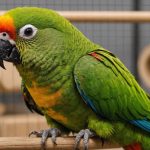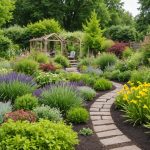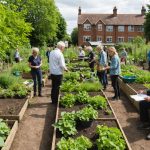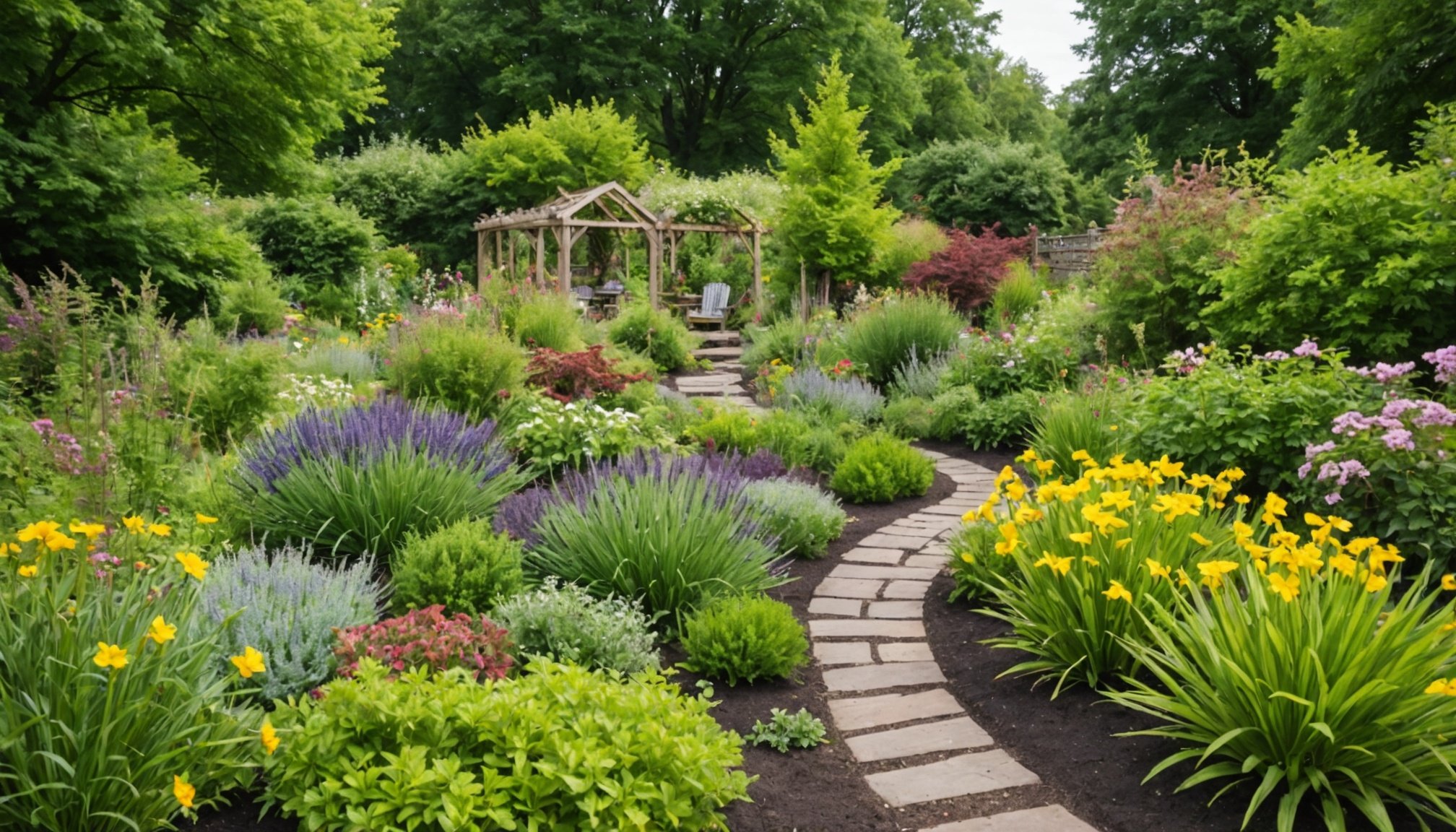Transform Your Garden: A Guide for UK Residents to Utilize Native Plants for a Wildlife-Friendly Oasis
Why Create a Wildlife-Friendly Garden?
In the heart of the UK, where urbanization and climate change are increasingly impacting local biodiversity, transforming your garden into a wildlife-friendly oasis is more crucial than ever. Your garden, no matter its size, can become a vital habitat for a variety of species, from birds and bees to butterflies and hedgehogs.
“Anyone can create a biodiverse garden,” says Dr. Mark Goddard, an urban ecologist, emphasizing the importance of debunking common myths about wildlife gardening.
Lire également : Boosting Urban Biodiversity: The Vital Role of UK Community Gardens in Conservation
By incorporating native plants and designing your garden with wildlife in mind, you not only enhance biodiversity but also create a beautiful and sustainable outdoor space that benefits both you and the environment.
Assessing Your Space
Before you begin, it’s essential to assess your garden or outdoor space. Here are some key factors to consider:
En parallèle : Revitalizing the UK’s Urban Waterways: Strategies to Enhance Aquatic Wildlife Habitats
Sunlight and Wind
Take note of the amount of sunlight your garden receives. Native plants have specific sunlight requirements, so choosing plants that match your garden’s conditions is vital. Similarly, consider the wind direction and speed, as some plants may need protection from harsh winds.
Available Space
Even small spaces like patios or balconies can be transformed into thriving wildlife habitats. Use vertical gardening options like wall-mounted planters, hanging baskets, or trellises to maximize space utilization.
Selecting Native Plants
Native plants are the foundation of any wildlife-friendly garden. Here’s why they are so important:
Food, Cover, and Breeding Grounds
Native plants provide essential resources for local wildlife, including food, cover, and places to raise their young. For example, monarch butterflies depend heavily on milkweed for reproduction and nectar plants for food during migration.
Keystone Plants
Keystone plants play an outsized role in supporting local ecosystems. These plants sustain up to 90% of butterfly and moth populations and up to 60% of native bees. Incorporating keystone plants into your garden maximizes its impact on local wildlife.
Steps to Create a Wildlife-Friendly Garden
Here are the detailed steps to transform your garden into a wildlife haven:
Choose the Right Containers
Ensure your containers have proper drainage. Use a mix of container sizes to create visual interest and support a range of species. For example, a minimum 36” round container or a 3×4 foot box or raised bed with drainage holes is ideal for three plants.
Create Layers and Shelter
Use plants of varying heights to mimic natural habitats. Taller plants like blazing star can act as shelters, while low-growing options provide cover for smaller creatures. Adding dense foliage or vines creates hiding spots for insects and small birds.
Add Potting Mix and Mulch
Use a high-quality potting mix specifically formulated for container gardening. Avoid using garden soil, as it may not provide adequate drainage. Add a layer of organic mulch on top of the soil to help retain moisture and promote healthy plant growth.
Provide Food and Water
Include shallow dishes of water for birds and insects. Consider adding a bird feeder or nectar feeder for hummingbirds. Native plants provide natural food sources, but these additional resources can supplement during dry periods.
Enhancing Your Wildlife Habitat
Here are some additional tips to make your garden even more welcoming to wildlife:
Attract Feathered Friends
Birds need food, water, and shelter. In addition to native plants, bird feeders and baths can attract songbirds to your garden. Position bird boxes in the right spots to provide safe spaces for nesting, raising young, and roosting.
Host Monarch Butterflies
Monarchs depend heavily on milkweed, their sole host plant for reproduction. Incorporating milkweed into your garden can directly contribute to monarch conservation.
Create a Wildflower Meadow
Wildflowers offer a source of nectar and potential breeding habitat for a range of species. Designate an area of your lawn for wildflowers or create a meadow in a pot for your patio or balcony. This not only provides a habitat for wildlife but also adds a pop of color to your garden.
Water Features for Wildlife
Water is a crucial element in any wildlife-friendly garden. Here’s how you can incorporate it:
Ponds and Mini Wetland Habitats
Ponds and mini wetland habitats are vital refuges for many species, including frogs, toads, and newts. Even a small container pond can make a significant difference. Ensure your pond has a shallow area for easy access and a deeper section for aquatic life.
Rain and Surface Water Management
Consider how water can be used to support biodiversity. Utilize existing water sources, minimize impermeable surfaces, and ensure any sustainable drainage system (SuDS) is multi-functional. This can provide food, shelter, homes, and safe corridors for wildlife.
Trees and Their Role in Wildlife Gardening
Trees are incredibly beneficial for both humans and wildlife. Here’s why you should include them in your garden design:
Benefits for Wildlife
Trees provide food, shelter, and breeding grounds for numerous species. They also help in maintaining soil quality and supporting local ecosystems. Choose trees that are most beneficial for your local wildlife, such as fruit trees that provide berries for birds and insects.
Planting and Care
Use guides to find out which trees are best for your area and how to plant and care for them. Proper care includes regular watering, pruning, and ensuring the tree has enough space to grow without competing with other plants.
Additional Features to Enhance Biodiversity
Here are some additional features you can include to make your garden even more wildlife-friendly:
Bug Hotels
Bug hotels provide shelter for insects and other small creatures. You can create your own bug hotel using natural materials like wood, bamboo, and leaves. This is a fun and eco-friendly project that can be done with minimal cost.
Hedgehog Highways
Hedgehogs are important indicator species for the health of our environment, but their numbers are in decline. Creating hedgehog highways by making small gaps in fences or walls can help them move freely between gardens. Also, consider creating wild patches and compost heaps to provide food and shelter.
Bird Feeders and Bird Boxes
Bird feeders and bird boxes are simple yet effective ways to attract birds to your garden. Position bird boxes in the right spots to provide safe spaces for nesting, raising young, and roosting. Use a variety of bird feeders to attract different species of birds.
Practical Tips and Maintenance
Here are some practical tips to keep your wildlife garden thriving:
Low Maintenance Gardening
Wildlife gardening doesn’t have to be high maintenance. Choose plants that are resilient and require minimal care. Use organic mulch to retain moisture and suppress weeds, reducing the need for frequent watering and weeding.
Eco-Friendly Practices
Adopt eco-friendly practices such as composting and using rainwater. Avoid using pesticides and herbicides, which can harm wildlife. Instead, use natural methods to control pests and weeds.
Transforming your garden into a wildlife-friendly oasis is a rewarding and impactful way to support local biodiversity. By selecting native plants, creating diverse habitats, and incorporating water features and additional wildlife-friendly elements, you can make a significant difference.
“Your garden can be a place for you to connect with nature and enjoy discovering the plants, animals, insects, and birds which might make it their home,” emphasizes the Parks Foundation, highlighting the personal and environmental benefits of wildlife gardening.
So, take the first step today. Read, learn, and get involved in creating a vibrant, sustainable habitat that makes a real difference in biodiversity conservation.
Detailed Bullet Point List: Key Elements for a Wildlife-Friendly Garden
- Native Plants: Choose plants that are native to your region to provide food, cover, and breeding grounds for local wildlife.
- Containers: Use containers with proper drainage and consider vertical gardening options to maximize space.
- Layers and Shelter: Use plants of varying heights to mimic natural habitats and provide shelter for smaller creatures.
- Potting Mix and Mulch: Use high-quality potting mix and organic mulch to promote healthy plant growth.
- Water Features: Include shallow dishes of water and consider creating ponds or mini wetland habitats.
- Trees: Plant trees that are beneficial for local wildlife, such as fruit trees.
- Bug Hotels: Create bug hotels using natural materials to provide shelter for insects.
- Hedgehog Highways: Make small gaps in fences or walls to help hedgehogs move freely between gardens.
- Bird Feeders and Bird Boxes: Use bird feeders and bird boxes to attract and support bird populations.
- Eco-Friendly Practices: Adopt practices like composting, using rainwater, and avoiding pesticides and herbicides.
Comprehensive Table: Benefits of Different Garden Features for Wildlife
| Garden Feature | Benefits for Wildlife | Examples |
|---|---|---|
| Native Plants | Food, cover, breeding grounds | Milkweed for monarch butterflies, wildflowers for pollinators |
| Containers | Maximizes space, visual interest | Vertical gardening, wall-mounted planters |
| Layers and Shelter | Shelter for smaller creatures | Taller plants like blazing star, low-growing options like thyme |
| Water Features | Drinking water, breeding habitats | Ponds, mini wetland habitats, shallow dishes of water |
| Trees | Food, shelter, breeding grounds | Fruit trees like apple or cherry, oak trees for insects |
| Bug Hotels | Shelter for insects | Bug hotels made from wood, bamboo, and leaves |
| Hedgehog Highways | Safe passage for hedgehogs | Small gaps in fences or walls |
| Bird Feeders and Bird Boxes | Food, shelter for birds | Seed feeders, nectar feeders, bird boxes for nesting |
| Eco-Friendly Practices | Healthy ecosystem, minimal harm | Composting, using rainwater, avoiding pesticides |
By following these guidelines and incorporating these features into your garden design, you can create a thriving wildlife oasis that not only supports local biodiversity but also enhances your own connection with nature.











